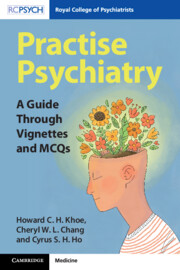Refine search
Actions for selected content:
307 results
Conclusion
-
- Book:
- Making Babies in Early Modern England
- Published online:
- 12 December 2025
- Print publication:
- 29 January 2026, pp 203-208
-
- Chapter
-
- You have access
- Open access
- HTML
- Export citation
6 - ‘Ordering’ Infants
-
- Book:
- Making Babies in Early Modern England
- Published online:
- 12 December 2025
- Print publication:
- 29 January 2026, pp 166-202
-
- Chapter
-
- You have access
- Open access
- HTML
- Export citation
10 - Human Nature
- from Part II - Theological Themes
-
-
- Book:
- The Origins of Scholasticism
- Published online:
- 18 November 2025
- Print publication:
- 08 January 2026, pp 284-308
-
- Chapter
- Export citation
Chapter 2 - Spices / English Digestion and Indigestion
- from Part I - The Dispensary
-
- Book:
- The Desire for Syria in Medieval England
- Published online:
- 01 December 2025
- Print publication:
- 18 December 2025, pp 65-92
-
- Chapter
- Export citation
Chapter 1 - Sweet Wine / The English Taste for the Blood of the Holy Land
- from Part I - The Dispensary
-
- Book:
- The Desire for Syria in Medieval England
- Published online:
- 01 December 2025
- Print publication:
- 18 December 2025, pp 41-64
-
- Chapter
- Export citation

Making Medical Progress
- History of a Contested Idea
-
- Published online:
- 12 December 2025
- Print publication:
- 20 November 2025
-
- Book
-
- You have access
- Open access
- Export citation
3 - Medical Progress as Becoming Free
-
- Book:
- Making Medical Progress
- Published online:
- 12 December 2025
- Print publication:
- 20 November 2025, pp 104-141
-
- Chapter
-
- You have access
- Open access
- HTML
- Export citation
1 - History
-
- Book:
- Making Medical Progress
- Published online:
- 12 December 2025
- Print publication:
- 20 November 2025, pp 34-65
-
- Chapter
-
- You have access
- Open access
- HTML
- Export citation
Introduction
-
- Book:
- Making Medical Progress
- Published online:
- 12 December 2025
- Print publication:
- 20 November 2025, pp 1-33
-
- Chapter
-
- You have access
- Open access
- HTML
- Export citation
Habit, medicine, and society in 18th-century Britain
-
- Journal:
- Medical History , First View
- Published online by Cambridge University Press:
- 17 November 2025, pp. 1-19
-
- Article
-
- You have access
- Open access
- HTML
- Export citation
7 - Medicine, Science, and the Environment
-
-
- Book:
- Explaining the History of American Foreign Relations
- Published online:
- 24 October 2025
- Print publication:
- 13 November 2025, pp 139-160
-
- Chapter
- Export citation
Therapies crossing borders in European state socialism, 1950-1990. Introduction to the special issue
-
- Journal:
- Medical History , First View
- Published online by Cambridge University Press:
- 07 November 2025, pp. 1-9
-
- Article
-
- You have access
- Open access
- HTML
- Export citation
Chapter 8 - ‘How to cultivate a love for reading’
- from Part II - Readers and Audiences
-
-
- Book:
- African Literature in Transition
- Published online:
- 23 October 2025
- Print publication:
- 06 November 2025, pp 166-183
-
- Chapter
- Export citation
21 - Medical and Scientific Writing
- from Part III - Genre and Medium in the Record
-
-
- Book:
- The New Cambridge History of the English Language
- Published online:
- 18 October 2025
- Print publication:
- 16 October 2025, pp 506-533
-
- Chapter
- Export citation
Bede’s Medical Books
-
- Journal:
- Early Medieval England and its Neighbours / Volume 51 / 2025
- Published online by Cambridge University Press:
- 07 October 2025, e13
-
- Article
-
- You have access
- Open access
- HTML
- Export citation
Assessing the Resilience of the Supply Chain of Medicines and Consumables during Disasters Based on the World Economic Forum Framework: A Case of Iran
-
- Journal:
- Disaster Medicine and Public Health Preparedness / Volume 19 / 2025
- Published online by Cambridge University Press:
- 19 September 2025, e266
-
- Article
- Export citation
Chapter 10 - Science
- from Part II - Themes and Issues
-
-
- Book:
- The Cambridge Companion to Modernist Theatre
- Published online:
- 28 August 2025
- Print publication:
- 11 September 2025, pp 180-197
-
- Chapter
- Export citation
The Doctors and the Party: Medicine, Politics, and the Habitus of Socialist Experts in the German Democratic Republic
-
- Journal:
- Central European History , First View
- Published online by Cambridge University Press:
- 09 September 2025, pp. 1-18
-
- Article
-
- You have access
- Open access
- HTML
- Export citation

Practise Psychiatry
- A Guide Through Vignettes and MCQs
-
- Published online:
- 04 September 2025
- Print publication:
- 18 September 2025
Parapēgmata and poleis: astrometeorological calendars in the Hellenistic city
-
- Journal:
- The Journal of Hellenic Studies / Volume 145 / November 2025
- Published online by Cambridge University Press:
- 26 August 2025, pp. 1-21
- Print publication:
- November 2025
-
- Article
-
- You have access
- Open access
- HTML
- Export citation
